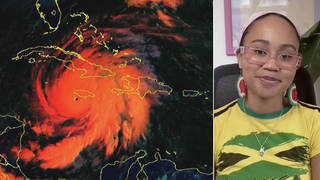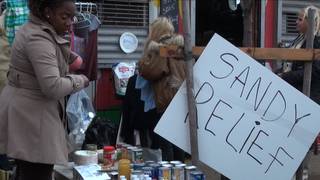
Guests
- Pamela BrownPh.D. student in sociology at the New School and one of the organizers of Strike Debt, which recently launched Rolling Jubilee.
An offshoot of Occupy Wall Street has launched a new movement called “Rolling Jubilee” to buy distressed debt from financial firms, often for pennies on the dollar, and then canceling it so that borrowers do not have to repay. The people who incurred the debt in the first place then get a certified letter informing them they are off the hook. Typically, financial institutions sell debt for pennies on the dollar to third parties who either try to collect on it or bundle it up for resale. However, the Rolling Jubilee activists say they are buying up the debt in order to “liberate debtors at random through a campaign of mutual support, good will, and collective refusal.” Tonight, Rolling Jubilee is holding a sold-out benefit concert in New York City to continue its anti-debt fundraising. The group says it has already raised $129,000 through online donations, which is enough to buy approximately $2.5 million worth of defaulted loans, due to their steep markdowns. We’re joined by Pamela Brown, a Ph.D. student in sociology at the New School and one of the organizers of the Rolling Jubilee. She also is participating in the Occupy Sandy efforts to organize local relief efforts to people hit hardest by Superstorm Sandy. [includes rush transcript]
Transcript
AMY GOODMAN: An offshoot of Occupy Wall Street has launched a new movement to bail out the people, not the banks. Coined “Rolling Jubilee,” activists are raising money to buy distressed debt from financial firms, often for pennies on the dollar, then canceling it so that borrowers don’t have to repay. The people who incurred the debt in the first place then get a certified letter informing them they’re off the hook. This is how Rolling Jubilee explains its campaign.
THOMAS GOKEY: The debts we have are not legitimate.
ANN LARSON: We shouldn’t be forced into debt to cover basic needs like healthcare, housing and education.
ROLLING JUBILEE ACTIVIST 1: We need a jubilee, a clean slate, a cancellation of debts for the 99 percent.
THOMAS GOKEY: Here’s how we’re going to do it. In America, banks sell debt on this shadowy market full of debt buyers. Debt collectors then turn around and try to extort the full amount from us.
ROLLING JUBILEE ACTIVIST 2: That’s where the Rolling Jubilee comes in. It raises money to buy the debt.
ROLLING JUBILEE ACTIVIST 3: But instead of collecting on the debts we buy, we’re going to abolish it. Poof! Shazam!
AMY GOODMAN: Tonight, Rolling Jubilee is holding a sold-out benefit concert in New York to continue its anti-debt fundraising. The group says it’s already raised $129,000 through online donations, which is enough to buy approximately two-and-a-half million dollars’ worth of defaulted loans due to their steep markdowns.
Well, for more, we’re joined by Pamela Brown, Ph.D. student in sociology at the New School, one of the organizers of the Rolling Jubilee.
Well, explain, Pam. How was this conceived? And who exactly is getting bailed out?
PAMELA BROWN: Right. Well, first of all, thank you so much for having me on your show, Amy.
Right, the Rolling Jubilee was an idea that was floating around for a while. And one of the people in the video we just saw, Thomas Gokey, brought that idea to a coalition that we formed earlier this summer called “Strike Debt.” And Strike Debt arose out of the Occupy Student Debt Campaign, Free University and Occupy Theory. And we came together, and we started to talk, and we realized that debt was really the tie that binds the 99 percent. It’s the intersection of Wall Street and our lives.
AMY GOODMAN: So, say more how Rolling Jubilee happens.
PAMELA BROWN: Right. So, it’s really actually a very simple idea, and yet no one has ever tried it before. But debt collectors do this all the time. What happens is that someone defaults on their debt—in other words, they cannot pay it—and the original creditor gives up on trying to collect it. And then a secondary round of people involved in the debt market, which is actually a $60 billion marketplace, decide that they’re going to try to collect on that debt. Obviously it’s not worth the original value, so the original creditors sell it for as low as five cents on the dollar, in many cases, and they sell it to a second round of collectors, collection debt buyers and collection agencies. And they then attempt to collect that debt. And, in fact, they do a pretty good job of it, because they make about $12.2 billion a year on collecting what was, in essence, defaulted debt.
AMY GOODMAN: Journalist Lindsay Beyerstein wrote an article called “Rolling Jubilee: How Does That Work?” for In These Times. She says the campaign may have unintended consequences comparable to those experienced by do-gooders who bought children out of slavery years ago. Beyerstein writes, quote, “The fatal flaw in this model was that the influx of American cash for child slaves drove up the price of children and encouraged slavers to capture more children. If Rolling Jubilee ever got off the ground in a big way, something similar would happen with credit card debt. The credit companies would make more predatory loans, and debt sellers would charge Rolling Jubilee more and more for the privilege of buying up the debt,” unquote. Pam Brown, what’s your thoughts on this?
PAMELA BROWN: Right. Well, so far we’ve raised about $185,000, and that’s by no means an amount that could really impact the system. There’s over $13 trillion of consumer debt. So, it’s an interesting idea. I’m not really sure how it would play out. But I don’t think that we’re anywhere close to that point where we’re really influencing the system that way.
And the idea behind the campaign is really to expose the predatory debt system. And also, if you think about it, by buying this debt for five cents on the dollar, approximately, what we are doing is we’re preventing profits, at least at this level, and we’re also helping people, because people are really suffering. I mean, we’ve gotten emails from people saying, you know, “I can only afford to contribute a dollar. I’m a single mother. I am broke. I’m being hounded by debt collectors.” And we know that the system is incredibly predatory and that it’s a racialized system, as well. Debt collectors target low-income communities of color regularly with predatory tactics, like entering judgments against them in court, things that they cannot defend themselves against, and then they’re able to make claim to their bank accounts and any assets that they have. So, that’s what we’re really trying to influence.
AMY GOODMAN: If you could—what about declaring bankruptcy as a way to challenge their debt?
PAMELA BROWN: There are many ways to strike debt, per se , and certainly bankruptcy is among them. It’s not as easy to do that as it used to be. And there are very interesting ways that that system breaks down based on subjective—subjective ideas that the judges have. For example, if you read in The Debt Resistors’ Operations Manual, which a publication that Strike Debt, the organization that has created the Rolling Jubilee, put out, you can find out that, with bankruptcy, it breaks down racially, in part because of just subjective ideas that the judges have, and they—and, too, all conditions being equal, will prefer white Americans for bankruptcy protection. And so, an African-American family trying to declare bankruptcy may find themselves in a situation where they’ve paid, because you have to pay to do this, and that they cannot declare bankruptcy, ultimately.
AMY GOODMAN: Can you talk about The Debt Resistors’ Operations Manual?
PAMELA BROWN: Sure. A few of us got together from Strike Debt and decided that it would be a good idea to try to come up with a mutual aid project where we could both explain our analysis of the debt system broadly, but also have tangible ways that people could use—things that they could actually do to help themselves as individuals, as well, while still proposing that we need a collective resistance to debt.
AMY GOODMAN: And how does this tie into student debt? Since you have been one of the major organizers around—around that campaign.
PAMELA BROWN: Right. Well, one of the things that we learned with the Occupy Student Debt Campaign was that one of the criticisms that people leveled against us was that student debt is really challenging to resist, because we’ve really lost all the consumer protections that would have allowed you to write student debt off in bankruptcy that allow you certain protections, really, that, you know, time it out, would—right now, student debt, you can—you’ll have for the rest of your life. And so, we realized that, and we realized that also we had to bind—we had to tie ourselves to other debtors. We had to tie ourselves to housing debt, to medical debt, to credit card debt, in order to actually build true economic resistance.
AMY GOODMAN: I don’t know if you’ve heard the latest controversial comments of the former presidential candidate, Mitt Romney, but he was recorded in a conference call to donors for—saying—blaming the loss on Obama’s gifts to various groups, including African Americans and Hispanics. And among the things, he said, “With regards to [the] young people, for instance, a forgiveness of college loan interest was a big gift.” So that’s how Obama got people to vote for him.
PAMELA BROWN: Right. Well, first of all, that was really incorrect because, along with that package, which kept interest rates for student loans down, we also lost interest rates for graduate student loans. So those interest rates actually went up, and the amount of volume that graduate loans ended up costing people went up, while perhaps the undergraduate education loans went down, or stayed the same, really.
AMY GOODMAN: Pam Brown, where is Occupy today? This is actually the anniversary of the police moving in on Occupy Wall Street at Zuccotti Park and eviscerating the encampment. But also we just experienced Superstorm Sandy.
PAMELA BROWN: Right.
AMY GOODMAN: And you went from help station to help station throughout New York that was being run by Occupy Sandy Relief.
PAMELA BROWN: Right. Well, I think that we’re at a moment that’s really interesting, where mutual aid has really become a very big part of what Occupy is doing. With Occupy Sandy, one of the things that I think that we’re going to see is that as this tragedy unfolds, more and more we’re going to see that debt is tied to this. We already know that Goldman Sachs has partnered with New York City to offer so-called low-interest loans, which at their core are predatory loans. You have to pay them back within two years, and even though the interest is low, that’s virtually impossible for a small business to do. So, I think that we’re going to see these two strands emerge. We look at debt as really the intersection of Wall Street and our lives. And what’s interesting there is that they evicted us from the park, and now this is kind of like a new battleground for resistance.
AMY GOODMAN: But Occupy Sandy Relief, what you found in these different areas? What were people doing during the superstorm?
PAMELA BROWN: Well, what was most interesting is that, just organically, Occupy was able to organize very quickly on the ground and provide real relief to people, provide food and clothing. People were donating all of these things. And the Red Cross wasn’t really able to reach out to people in the way that was necessary to distribute those goods. And Occupy really took that on.
AMY GOODMAN: It so infuriated the Staten Island borough president, a Republican, James Molinaro, that he said that people should not donate to the Red Cross.
PAMELA BROWN: Yes, and they probably shouldn’t. There’s—online, you can go to Amazon, and you can find the Occupy Sandy Relief registry, so you can actually donate what people need. One of the things that Occupy has been amazing at with Sandy has been actually going to people, talking to them and saying, “What is it that you actually need?” and providing that. And that’s, I think, what we can do really uniquely, although, of course, we’re not really a relief organization per se, it’s really interesting that the networks that we’ve formed over the last year could really come together in such an amazing way to actually help people in their day-to-day lives and bring some of the ideas that we have about inequality and economic resistance to them.
AMY GOODMAN: The website for Rolling Jubilee?
PAMELA BROWN: It’s rollingjubilee.org. And you can also go strikedebt.org, where you’ll be able to download The Debt Resistors’ Operations Manual and find much more about what we’re up to.
AMY GOODMAN: Pam, thanks very much for being with us.
PAMELA BROWN: Thank you.
AMY GOODMAN: Pamela Brown, a Ph.D. student in sociology at the New School, one of the organizers of Strike Debt, which recently launched Rolling Jubilee.












Media Options